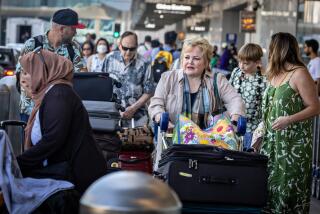Screening Plan for Airport Baggage Is Seen as Wasteful
- Share via
WASHINGTON — The government’s effort to bolster the security of airline baggage risks wasting billions of dollars on subpar technology because of a rush to complete the project this year, a report to be released today concludes.
Instead, Congress and the Bush administration should set a more realistic goal of December 2004 for screening 1 billion checked bags a year for hidden bombs and appoint a special scientific board to guide the program, the Los Angeles-based Reason Foundation recommended.
The study by the libertarian think tank crystallizes mounting concerns among security experts, airport and airline executives, and some government officials.
The foundation estimated that the new Transportation Security Administration will spend $3 billion to $12 billion attempting to meet a Dec. 31 congressional deadline for screening checked bags with some combination of machines to detect explosives. Existing technologies have drawbacks, ranging from high false alarm rates to frequent breakdowns to time-consuming requirements for opening a large proportion of bags.
“The forthcoming Cabinet agency for homeland security will have an initial budget of $37 billion to deal with the entire range of security threats--to buildings, water supply, power plants, population. It seems hugely out of proportion to be spending up to $12 billion on airline baggage inspection, when the full scope of security threats is so enormous,” said the report.
Rep. John L. Mica (R-Fla.), chairman of the House aviation subcommittee, said he plans to hold a hearing shortly on the issues raised by the Reason Foundation study. The report concludes that the congressional deadline cannot be met because of a variety of problems, including not enough time to procure thousands of machines.
Transportation Department officials insist they will fulfill the congressional timetable, unless lawmakers amend it. “If Congress wants to change its mind, that’s fine,” Transportation Secretary Norman Y. Mineta said in a recent interview.
The report also urged the government to shift the focus of aviation security from bags to people. That would involve making more extensive use of computerized profiling to identify people who may pose a threat, as well as creating a “trusted traveler” program to exempt those who fly often from added searches. Computerized profiling is already in use, and the government is conducting research into ways of expanding it.
To meet the bag-screening deadline, the security agency plans to deploy 1,100 computerized tomography scanners, which generate three-dimensional images of objects inside closed bags. The scanners will be supplemented with 4,700 trace-detection systems, which can pick up residue left by explosives on the outside of closed bags or amid the contents of open ones. Millions of checked bags will have to be opened to ensure the effectiveness of the trace systems, officials say.
Airlines are warning that it is foolhardy to attempt to achieve such a difficult goal during the peak holiday travel season at the end of the year. The Reason Foundation urged Congress to create a scientific advisory panel to guide the design of a better system for screening bags.
“Checked baggage screening is a semi-disaster, because you don’t have the equipment,” Mica said. “Some of the deadlines Congress put in place were not realistic in the first place.”
More to Read
Sign up for Essential California
The most important California stories and recommendations in your inbox every morning.
You may occasionally receive promotional content from the Los Angeles Times.










